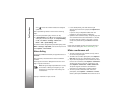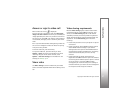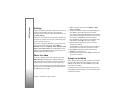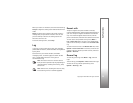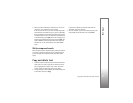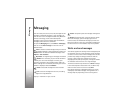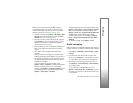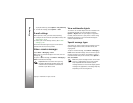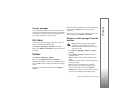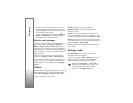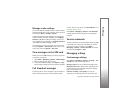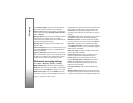
Messaging
32
Copyright © 2007 Nokia. All rights reserved.
Messaging
You can create, send, receive, view, edit, and organize text
messages, multimedia messages, e-mail messages, etc.
You can also receive messages and data using Bluetooth
wireless technology, receive and forward picture
messages, receive service messages and cell broadcast
messages, and send service commands.
To open the Messaging menu, select Menu > Messaging.
You can see the New message function and a list of
default folders:
Inbox—contains received messages except e-mail and
cell broadcast messages. E-mail messages are saved in the
Mailbox folder. To read cell broadcast messages, select
Options > Cell broadcast.
My folders—for organizing your messages into folders
Mailbox—for connecting to your remote mailbox to
retrieve your new e-mail messages or viewing your
previously retrieved e-mail messages offline. After you
define settings for a new mailbox, the name given to that
mailbox is displayed instead of Mailbox.
Drafts—saves draft messages that have not been
sent.
Sent—saves the messages that are sent, excluding
messages sent using Bluetooth.
Outbox—temporarily saves the messages waiting to be
sent.
Reports (network service)—saves the delivery reports
of the text messages, special message types such as
business cards, and multimedia messages you have sent.
Receiving a delivery report of a multimedia message that
has been sent to an e-mail address may not be possible.
Write and send messages
Your device supports the sending of text messages beyond
the character limit for a single message. Longer messages
are sent as a series of two or more messages. Your service
provider may charge accordingly. Characters that use
accents or other marks, and characters from some
language options, take up more space, limiting the number
of characters that can be sent in a single message.
The wireless network may limit the size of MMS messages.
If the inserted picture exceeds this limit, the device may
make it smaller so that it can be sent by MMS.
Only devices that have compatible features can receive
and display multimedia messages. The appearance of a
message may vary depending on the receiving device.



